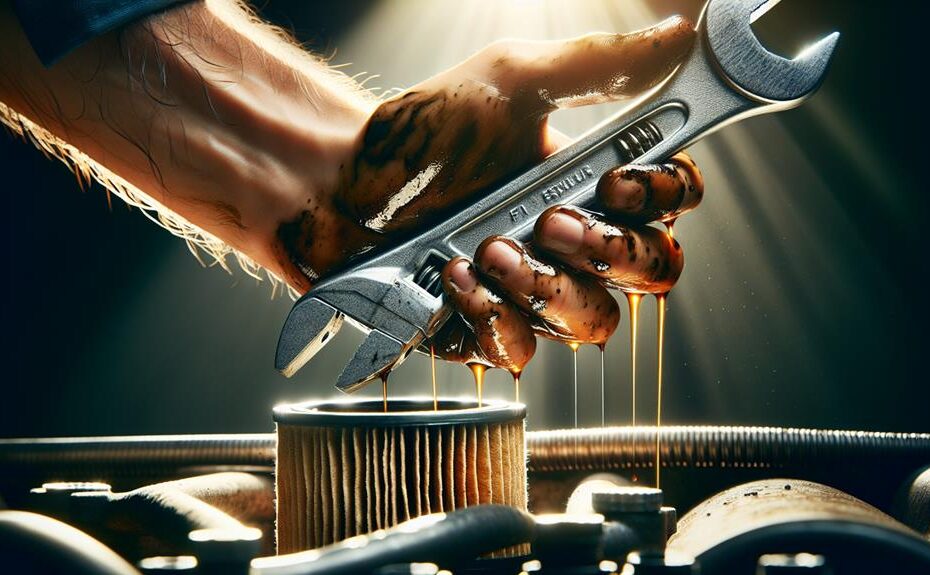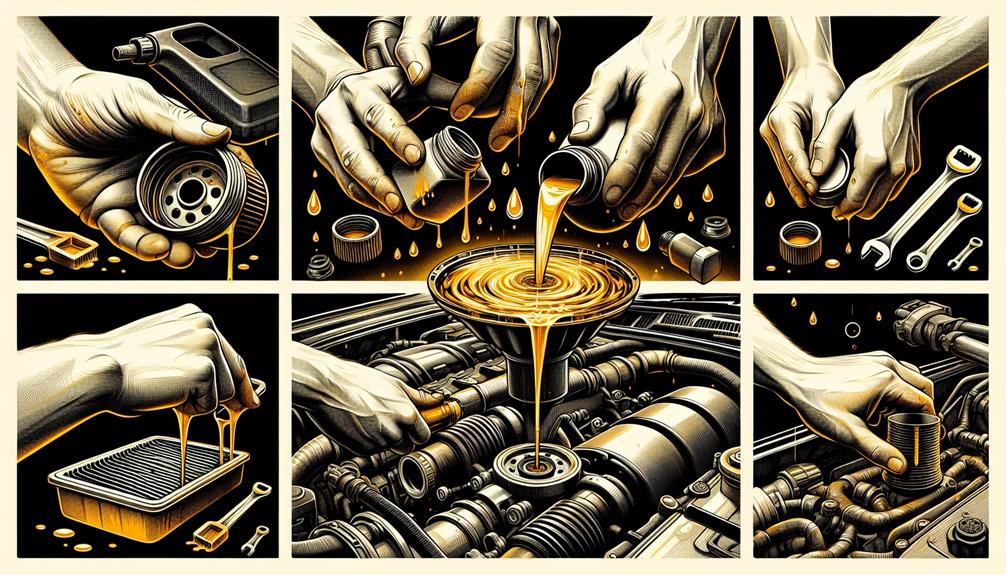Did you know that changing your oil filter during an oil change can improve your vehicle's performance by up to 10%? It's true! The oil filter plays a crucial role in keeping your engine clean and free from harmful contaminants.
But how exactly do you go about changing it? In this simple guide, we'll walk you through the steps you need to take to successfully remove and replace your oil filter.
By the end of this article, you'll have all the knowledge you need to ensure a smooth and efficient oil change process.
So, let's get started!
Key Takeaways
- Regularly changing the oil filter helps maintain engine efficiency and longevity.
- A clogged oil filter can lead to reduced oil pressure and poor lubrication.
- Different types of oil filters available include spin-on filters and cartridge filters.
- When installing a new oil filter, it is important to hand-tighten it until snug, check for leaks, and adjust if necessary.
Importance of Changing the Oil Filter
Changing the oil filter is a crucial step in maintaining the efficiency and longevity of your vehicle's engine. The oil filter plays a vital role in keeping the engine clean by removing contaminants from the oil. By doing so, it prevents these particles from circulating and causing damage to critical engine components.
One of the advantages of using synthetic oil is that it helps in keeping the oil filter clean for longer periods. Synthetic oil has a higher resistance to breakdown, which means it can withstand higher temperatures and remain effective for a more extended period. This reduces the chances of the oil filter getting clogged quickly and ensures optimal engine performance.
A clogged oil filter can lead to various issues. One of the signs of a clogged oil filter is reduced oil pressure. When the filter is clogged, the flow of oil becomes restricted, resulting in lower oil pressure. This can cause engine parts to experience more friction and wear, leading to potential engine damage. Additionally, a clogged oil filter may result in poor lubrication, which can cause excessive heat and premature engine wear.
To avoid these problems, it's essential to change the oil filter regularly during the oil change. By doing so, you can ensure that your engine remains clean and well-lubricated, promoting optimal performance and extending its longevity.
Tools Needed for Changing the Oil Filter
When performing an oil change, it's important to have the necessary tools for changing the oil filter to ensure the continued efficiency and longevity of your vehicle's engine.
The oil filter plays a crucial role in keeping your engine clean and free from harmful contaminants.
There are different types of oil filters available in the market, such as spin-on filters and cartridge filters. Spin-on filters are the most common type and are easy to install and replace. On the other hand, cartridge filters require a filter wrench to remove the housing before replacing the filter element.
Regardless of the type of oil filter your vehicle uses, there are a few essential tools you'll need. These include a socket wrench or oil filter wrench to remove the old filter, a drain pan to catch the oil, gloves to protect your hands, and a funnel to pour in the new oil.
Locating the Oil Filter in Your Vehicle
To locate the oil filter in your vehicle, consult your vehicle's owner's manual or use an online resource specific to your make and model. These resources will provide you with precise instructions on the location of the oil filter in your particular vehicle. However, I can give you a general idea of where you might find it.
In most vehicles, the oil filter is located underneath the engine, near the oil pan. It is usually cylindrical in shape and has a metal or plastic casing. To give you a visual representation, here is a table illustrating the possible locations of the oil filter in different types of vehicles:
| Vehicle Type | Oil Filter Location |
|---|---|
| Sedan | Underneath the engine, towards the front or side |
| SUV | Underneath the engine, towards the front or side |
| Truck | Underneath the engine, towards the front or side |
| Sports Car | Underneath the engine, towards the rear or side |
When changing the oil filter, it is important to note that different types of oil filters are available. Some common types include spin-on filters, cartridge filters, and magnetic filters. The method for removing a stuck oil filter may vary depending on the type of filter you have. It is always recommended to refer to your owner's manual or consult a professional if you encounter any difficulties.
Steps to Remove and Replace the Oil Filter
To remove and replace the oil filter, follow these steps.
First, ensure that the engine is cool and the vehicle is parked on level ground.
Locate the oil filter, which is typically found on the side or underneath the engine.
Before removing the filter, place a drain pan beneath it to catch any residual oil.
Using an oil filter wrench, carefully loosen the filter by turning it counterclockwise. Be cautious not to spill any oil during this process.
Once the filter is loose, use your hand to unscrew it completely.
Take note of the position and orientation of the old filter to ensure proper installation of the new one.
Before installing the new filter, apply a small amount of clean oil to the rubber gasket. This helps create a proper seal and prevents leaks.
Screw the new filter onto the engine by hand, making sure it's snug but not overly tightened.
Finally, use the oil filter wrench to give it a quarter turn to ensure a secure fit.
This completes the process of removing and replacing the oil filter.
Regular oil filter maintenance is crucial to maintain the overall health of your engine.
Using a high-quality oil filter offers the added benefit of better filtration and improved engine performance.
Tips for Properly Installing a New Oil Filter
For proper installation of a new oil filter, ensure that the engine is cool and the vehicle is parked on level ground. Follow these tips to avoid oil leaks and common mistakes when installing oil filters:
- Hand-tighten the filter: Use your hand to tighten the filter until it's snug. Don't overtighten as it can cause damage to the filter or the engine.
- Check the old filter's gasket: Before installing the new filter, make sure the old filter's gasket isn't stuck to the engine. If it is, remove it to prevent leaks.
- Apply a thin layer of oil: Prior to installing the new filter, apply a thin layer of fresh oil to the rubber gasket. This helps create a proper seal and prevents the gasket from sticking.
- Check for leaks after starting the engine: Once you have installed the new filter and added fresh oil, start the engine and let it run for a few minutes. Then, check for any leaks around the filter area. If you notice any leaks, stop the engine and tighten the filter a little more.
Frequently Asked Questions
How Often Should the Oil Filter Be Changed?
You should change the oil filter every 3,000 to 5,000 miles. Synthetic oil in the filter provides better protection and lasts longer, but it can be more expensive. Choose the right filter based on your vehicle's make and model.
What Are the Signs That the Oil Filter Needs to Be Replaced?
To know if your oil filter needs replacing, watch out for signs such as poor engine performance, dirty exhaust smoke, or low oil pressure. Regular oil filter maintenance is crucial to ensure optimal engine function.
Can I Reuse an Old Oil Filter?
No, you can't reuse an old oil filter. While it may seem tempting to save a few bucks, using a new filter ensures optimal engine performance and prevents potential damage. Don't risk it.
Is It Necessary to Change the Oil Filter Every Time I Change the Oil?
Yes, it is necessary to change the oil filter every time you change the oil. Regular oil filter changes are important to maintain optimal engine performance and extend the lifespan of your oil filter.
Are All Oil Filters Compatible With Every Vehicle?
Not all oil filters are compatible with every vehicle. Different vehicles require different oil filter types. Make sure to check your vehicle's specifications and consult your owner's manual to ensure compatibility.
Conclusion
In conclusion, changing the oil filter during an oil change is a crucial step in maintaining the health and performance of your vehicle.
One interesting statistic to note is that a clogged or dirty oil filter can reduce fuel efficiency by up to 10%.
Therefore, regularly replacing the oil filter ensures optimal engine performance and helps save on fuel costs.
Follow the simple steps outlined in this guide to properly install a new oil filter and keep your vehicle running smoothly.



